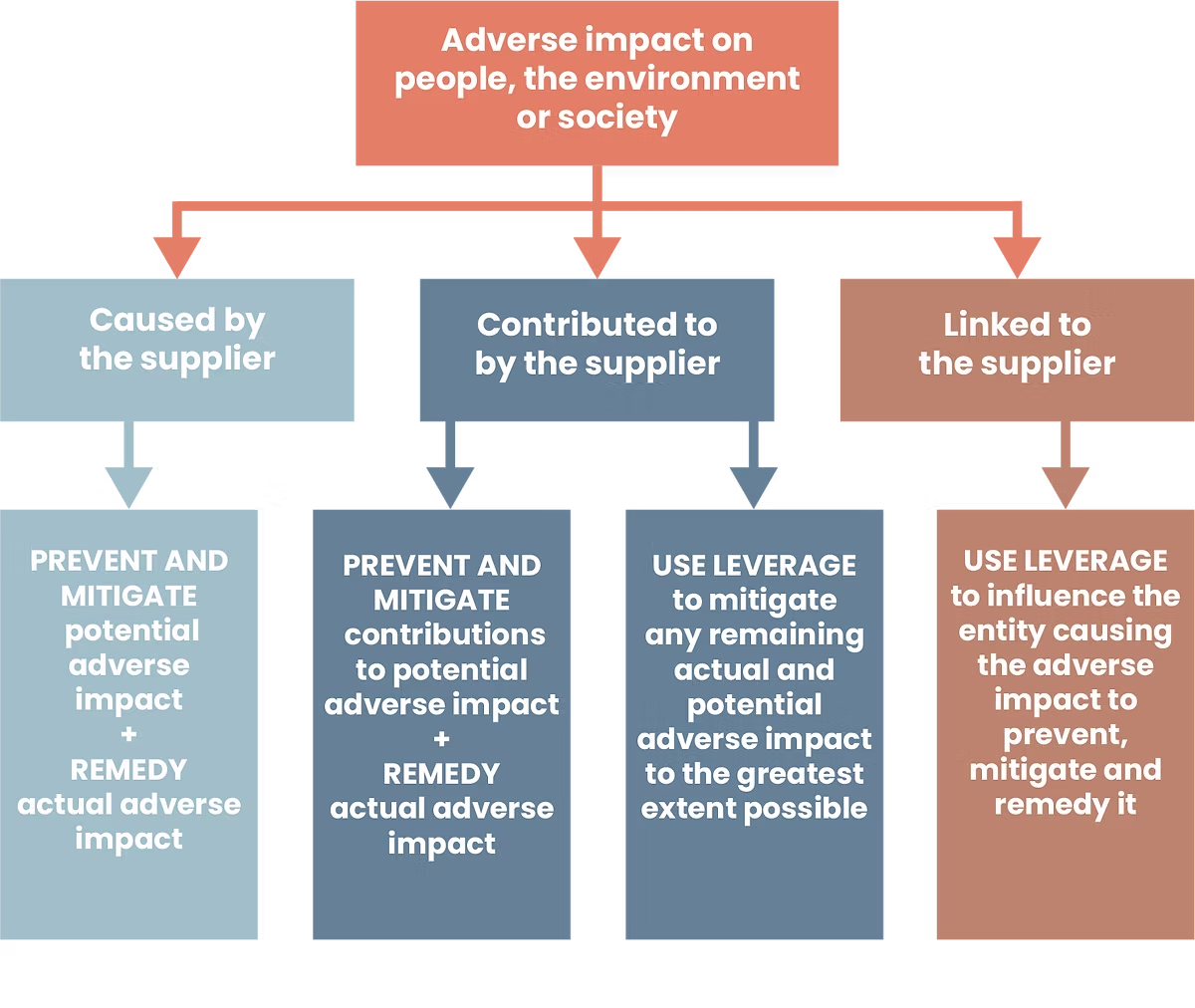Process requirement 7

We explain the concept of remediation, when remediation is required, the importance of engaging in meaningful consultation with affected rights-holders, and the need to assess whether they are satisfied with both the process and the outcome.
Excerpt from the contract clause
Supplier shall, if Supplier has caused or contributed to actual adverse impact, provide for remediation by
a) to the extent possible, restoring affected rights-holders to the situation they would have been in had the adverse impact not occurred and enabling remediation that is proportionate to the significance and scale of the adverse impact,
b) engaging in meaningful consultation with affected rights-holders or their representatives on appropriate remedy and
c) assessing whether affected rights-holders are satisfied with the process and outcome.
Remediation
If you have caused or contributed to actual adverse impact, you shall provide for remediation.
“Remediation and remedy refer to both the processes of providing remedy and the substantive outcomes that can counteract, or make good, the adverse impact. These outcomes may take a range of forms, such as apologies, restitution, rehabilitation, financial or non-financial compensation, and punitive sanctions (criminal or administrative, such as fines), as well as the prevention of harm through, for example, injunctions or guarantees of non-repetition.”
Even with the best policies and processes in place, you may cause or contribute to an adverse impact that was unforeseen or impossible to prevent. If such a situation arises, you shall actively work towards remediation—either independently or in collaboration with other actors.
However, if you have not caused or contributed to the adverse impact but are still linked to it, you are not expected to provide for remediation. Instead, you should use your leverage to influence the entity causing the adverse impact to remedy it, for example by asking questions.
Below is an illustration of this responsibility:

You shall have processes in place that enable remediation in cases of actual adverse impacts. Some companies have processes designed to address specific actual adverse impacts. The drawback of this approach is that it may lack a clear framework for less predictable situations. Therefore, it is beneficial to have a comprehensive remediation process across all areas of operation, which can be broken down into separate processes for, for example, employees and external rights-holders.
The appropriate procedure in a given case depends on several factors, including legal obligations, rights-holders’ preferences, access to remediation procedures, the nature of the impact, and whether the adverse impact occurs within your own operations or in the supply chain.
We have developed a template for mapping remediation procedures, which can be found below under Templates process requirement 7. It is not a requirement to use this template, just support.
In certain circumstances, it may also be most appropriate for the remediation process to be handled by a party other than the one causing or contributing to the adverse impact.
Remediation provided by another party
If you have contributed to the impact but another party, such as a sub-supplier or security forces, has caused it and is either providing remedy or being held accountable by authorities, you should generally await that outcome. In such situations, you shall cooperate with ongoing processes. You should also maintain pressure on the other party, for example by asking questions.
Court proceedings or other government procedures
If there is an ongoing court or other government procedure, it may be necessary or at least appropriate for you to wait for that procedure to conclude rather than enter into remediation. This is particularly relevant if a crime is suspected. Here too, you shall cooperate with the ongoing process.
Examples of other government procedures include ombudsmen, labour protection authorities, environmental protection authorities, national human rights institutions and national contact points (NCPs) under the OECD Guidelines for Multinational Enterprises.
The NCPs are tasked with strengthening compliance with the OECD Guidelines. They do this by promoting the Guidelines, handling cases and contributing to solutions when questions arise about compliance in specific cases. Individuals and organisations can report a company to the NCP in the country where the company operates or is based, regardless of where in the world the impact has occurred. The NCP facilitates consensual solutions and non-adversarial processes, such as conciliation or mediation, to help the parties deal with the issues. After the process is completed, the NCP is obliged to publish its conclusions and may also make recommendations based on the circumstances of the case. The Swedish NCP consists of representatives from several ministries within the Government Offices as well as trade unions and the business community.
Other procedures
Examples of other procedures include collective bargaining agreements, global agreements between companies and unions, multi-stakeholder complaints procedures (see examples under Process Requirement 6) and community-based complaints procedures, including local traditional procedures.
Questions of complicity
Questions of complicity may arise if you contribute to, or are perceived to contribute to, adverse impacts caused by another party. The concept of complicity has both legal and non-legal dimensions.
In a non-legal context, you may be perceived as “complicit” in another party’s actions, for example if you are considered to benefit from a violation committed by that party.
Legally, most national laws prohibit complicity in crime, and some – but not Sweden – allow criminal liability for companies in such cases. Additionally, in some cases, civil lawsuits can be initiated based on a company’s alleged contribution to an injury.
Restoring affected rights-holders
You shall, to the extent possible, restore affected rights-holders to the situation they would have been in had the adverse impact not occurred and enable remediation that is proportionate to the significance and scale of the adverse impact.
Restoring affected rights-holders to the situation they would have been in had the adverse impact not occurred is equivalent to remedying the adverse impact.
The phrase “to the extent possible” acknowledges that some harms — such as loss of life or limb due to corporate actions or omissions — cannot be fully restored.
What constitutes a proportionate remedy, in relation to the significance and scale of the adverse impact, must be assessed on a case-by-case basis in consultation with the affected rights-holders.
In the supply chain risk assessment template we have developed, which can be found below under Templates process requirement 7, we help you establish a remediation plan. We have also developed a corresponding template for your own operations. There is no requirement to use these templates. You can demonstrate that you meet the requirement to restore affected rights-holders in other ways.

Suggested verifications
- Instructions describing your remediation processes, either covering all areas of operation or divided between your own operations and the supply chain.
- Remediation plans for sample products.
- Meeting minutes where decisions on remediation have been recorded, for sample products.
- Remediation agreements for sample products.
Guidance for auditor
Fulfils requirement
The company has instructions or equivalent documentation/templates that describe how—if it has caused or contributed to adverse impact—it remediates affected rights-holders in its own operations and supply chains, including:
- How the company, to the extent possible, restores affected rights-holders to the situation they would have been in had the adverse impact not occurred.
- How the company enables remedies that are proportionate to the significance and scale of the adverse impacts.
There is evidence that the company has remediated affected rightsholders, such as implemented remediation plans, meeting minutes and/or remediation agreements.
Does not fulfil requirement
The company lacks instructions or equivalent documentation/templates that describe how—if it has caused or contributed to adverse impacts—it remediates affected rights-holders in its own operations and supply chains, or they are incomplete:
- It is not clear that the company, to the extent possible, restores affected rights-holders to the situation they would have been in had the adverse impact not occurred.
- It is not clear that the company enables remedies that are proportionate to the significance and scale of the adverse impact.
- Instructions or similar documentation are available for remediation in the company’s own operations, but not for remediation in the supply chain.
There is no evidence that the company has remediated affected rightsholders, such as implemented remediation plans, meeting minutes and/or remediation agreements.
Engaging in meaningful consultations
You shall engage in meaningful consultation with affected rights-holders or their representatives on appropriate remedy. The following can serve as guidance when assessing suitable remedy:
- Existing standards – In some cases, national or international standards and laws define what constitutes appropriate remediation.
- Precedents – If no specific standards exist, you can refer to previous similar cases and adapt your measures accordingly.
- Stakeholder preferences – The perspectives of affected individuals are crucial, particularly in cases of human rights violations. Listening to their needs and expectations can help ensure more relevant and fair remediation.
When existing standards, precedents and stakeholder preferences are not aligned, stakeholder preferences should be prioritised.
One example of an area where precedents exist is the reimbursement of recruitment fees to migrant workers, as a measure to remediate debt bondage. Below are two relevant guidelines:
Meaningful consultations
As usual, consultations shall be meaningful. This means that they shall be characterised by two-way communication, good faith and responsiveness, and be ongoing.
If no agreement can be reached
If you and the affected parties cannot agree on an appropriate remedy, it may be necessary to involve a neutral third party as a mediator or to turn to a court for review.
A mediator shall be freely accepted by you and the affected parties. The mediator’s role is to help you both find a shared solution, but no one can be forced to accept a particular outcome. If you and the affected parties reach an agreement, you can also agree that it will be binding.
Review means that the outcome does not require your consent or that of the affected party, and that it is often binding. Review can be through a court, an ombudsman, a national human rights institution or another body that has jurisdiction or that the parties jointly agree to.

Suggested verifications
- Instructions describing the consultations with rights-holders in the remediation process.
- Meeting minutes from consultations with rights-holders, for sample products.
- Documentation from mediation or rulings, for sample products.
Guidance for auditor
Fulfils requirement
The company has instructions or equivalent documentation that describe how it engages in consultations with affected rights-holders, or their representatives, on appropriate remedies, including:
- How consultations shall be characterised by two-way communication, responsiveness, good faith and continuity.
There is evidence, such as meeting minutes, that shows that the company has engaged in meaningful consultation with affected rightsholders, or their representatives, on appropriate remedy.
Does not fulfil requirement
The company lacks instructions or equivalent documentation that describe how it engages in consultations with affected rights-holders, or their representatives, on appropriate remedies, or they are incomplete:
- It is not clear that consultations shall be characterised by two-way communication, responsiveness, good faith and continuity.
There is no evidence, such as meeting minutes, that shows that the company has engaged in meaningful consultation with affected rightsholders, or their representatives, on appropriate remedy.
Assessing satisfaction
You shall assess whether affected rights-holders are satisfied with the process and outcome.
The purpose of the evaluation is to ensure that the adverse impacts have been addressed and to gather lessons for future remediation efforts. The evaluation also sends an important signal to affected rights-holders that their opinions matter, which can foster dialogue and help prevent future issues from escalating or complaints from worsening.
Examples of methods that can be used to assess satisfaction include surveys and interviews. We have developed a survey template, which can be found under Templates process requirement 7. It is not a requirement to use this template. You can demonstrate compliance in other ways.

Suggested verifications
- Instructions describing the assessment of rights-holders’ satisfaction with the process and outcome.
- Summaries of or reports from conducted assessments, for sample products.
Guidance for auditor
Fulfils requirement
The company has instructions or equivalent documentation/templates that describe how it assesses affected rights-holders’ satisfaction with the process and the outcome.
There is evidence that the company has assessed affected rightsholders’ satisfaction with the process and outcome, such as surveys or summaries of/reports from completed assessments.
Does not fulfil requirement
The company lacks instructions or equivalent documentation/templates that describe how it assesses affected rights-holders’ satisfaction with the process and the outcome.
There is no evidence that the company has assessed affected rightsholders’ satisfaction with the process and outcome, such as surveys or summaries of/reports from completed assessments.

Templates process requirement 7
- Complaints procedure template
- Responsible sourcing instruction template (section 4) (currently under revision)
- Template for mapping procedures for remediation
- Remediation plan template for own operations
- Supply chain risk assessment template incl. action plans and remediation plan
- Survey template for assessment of satisfaction with process and outcome
Process requirements
Integrate commitments into policies and allocate responsibility for policies and due diligence
We explain the requirements for policies and how responsibilities shall be allocated between the board of directors, managers, and employees.
Identify and assess adverse impacts
We explain the concepts of risk suppliers, supply chain mapping, rights-holder consultations and particularly vulnerable groups, as well as how to prioritise risks based on likelihood and severity.
Prevent and mitigate adverse impacts that you cause or contribute to
We explain the responsibility to cease activities that cause or contribute to adverse impacts, establish action plans, and promote sustainable purchasing practices.
Prevent and mitigate adverse impacts linked to your operations
We explain the responsibility regarding supplier assessments, action plans, and the forwarding of requirements—including transparency—as well as the ability to temporarily suspend or terminate the contract.
Monitor the measures to prevent and mitigate adverse impacts
We explain what we mean by following-up action plans, meaningful consultations with rights-holders, and addressing deviations.
Enable complaints
We explain the key functions of complaints procedures, for which stakeholders they should be accessible, and the need to address submitted complaints.
Provide for remediation
We explain the concept of remediation, when remediation is required, the importance of engaging in meaningful consultation with affected rights-holders, and the need to assess whether they are satisfied with both the process and the outcome.